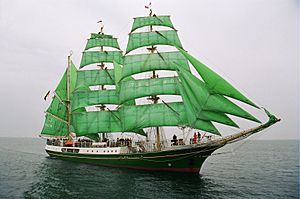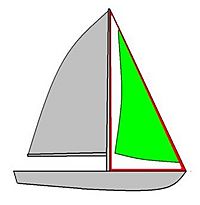Jib facts for kids

A jib is a special kind of sail shaped like a triangle. It's found at the front of a sailing boat, ahead of the main front mast. The bottom front corner of the jib, called the tack, is attached to the bowsprit (a pole sticking out from the front of the boat), to the very front of the boat, or to the deck between the bowsprit and the front mast.
Jibs are one of the two main types of headsails on modern boats. Headsails are any sails set forward of the front-most mast. The other main type of headsail is a spinnaker, which is usually much larger and used for sailing with the wind.
Jibs on Older Ships
On older sailing ships, like Schooners, you might see several jibs. A schooner often had up to three jibs.
- The one highest up, on the topmast forestay (a wire supporting the mast), was usually called the jib topsail.
- A second jib, on the main forestay, was simply called the jib.
- The jib closest to the mast was known as the staysail.
Large square-rigged ships, which have many square sails, could have even more jibs, sometimes as many as six! These jibs were named based on their position from the very front of the boat (fore) to the back (aft):
- Jib of jibs
- Spindle jib
- Flying jib
- Outer jib
- Inner jib
- Fore (topmast) staysail
The "jib of jibs" and "spindle jib" were not used very often. They were mostly seen on fast clipper ships when the winds were very light. A "storm jib" was a smaller, very strong jib made of thick canvas. Sailors would use it in bad weather to help control the ship.
Jibs on Modern Boats
Sometimes, a boat can sail using only a jib. However, most of the time, the jib helps the mainsail (the main sail behind the mast) rather than doing all the work itself. The jib's most important job is to act like an airfoil, which helps the mainsail work better. This increases the boat's speed and overall stability.
On boats with only one jib, the bottom back corner, called the clew, often extends further back than the mast. This means the jib and mainsail overlap. An overlapping jib like this is called a genoa jib or simply a genoa. These are very effective when sailing with the wind coming from the side, a sailing direction called reaching.
Boats might also carry smaller, tougher jibs. These are used when the mainsail is reefed (made smaller) in strong winds. These strong sails are called storm jibs or spitfires.
Some boats have two staysails. The inner sail is called the staysail, and the outer (front-most) one is called the jib. This setup with two staysails is known as a cutter rig. In North America, it's sometimes called a yankee pair. A boat with one mast that uses two staysails and a mainsail is called a cutter.
When a yacht is tacking (turning the front of the boat through the wind), the jib needs to be managed carefully. Most cruising yachts and racing sailboats have two sheets (ropes) attached to the jib's clew. As the yacht turns into the wind, the rope that was pulling the jib (the "active sheet") is let go. At the same time, the other rope (the "lazy sheet") on the other side of the boat is pulled in. This "lazy sheet" then becomes the new "active sheet" until the boat tacks again.
Images for kids
See also
 In Spanish: Foque para niños
In Spanish: Foque para niños




